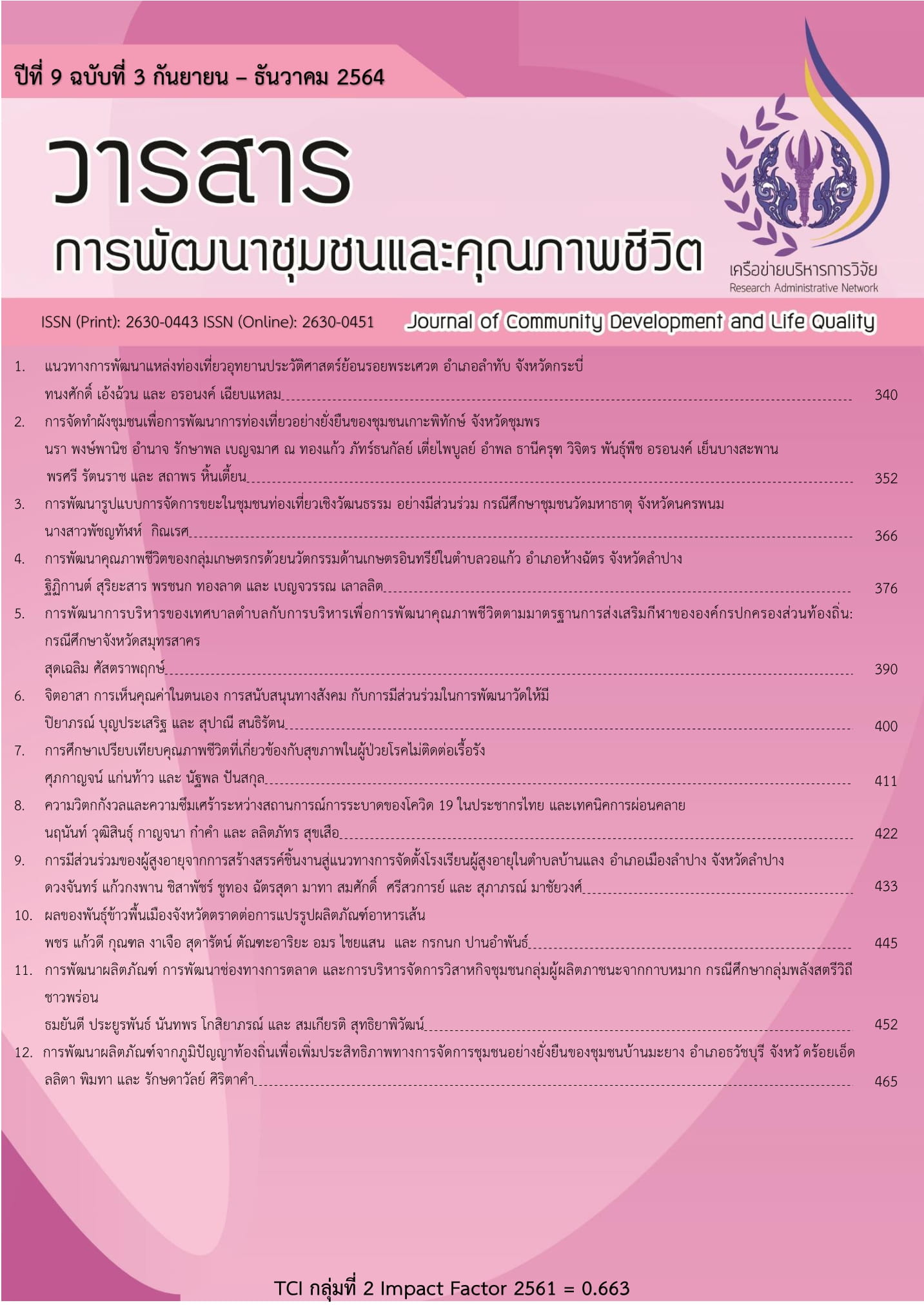ผลของพันธุ์ข้าวพื้นเมืองจังหวัดตราดต่อการแปรรูปผลิตภัณฑ์อาหารเส้น
Main Article Content
บทคัดย่อ
การวิจัยนี้จัดทำโดยกระบวนการมีส่วนร่วมของชุมชนบ้านทุ่งไก่ดัก และคณะนักวิจัย ใช้วิธีการเลือกกลุ่มตัวอย่างแบบเจาะจง คือ สมาชิกชุมชนบ้านทุ่งไก่ ดักหมู่ที่ 4 ตำบลท่ากุ่ม อำเภอเมืองตราด จังหวัดตราด เก็บข้อมูลโดยการสัมภาษณ์ จัดเวทีถอดบทเรียนภูมิปัญญาท้องถิ่น แปรรูปผลิตภัณฑ์ การทดสอบทางด้านประสาทสัมผัส และการวิเคราะห์ค่าดัชนีน้ำตาลในห้องปฏิบัติการ ดำเนินการแปรรูปผลิตภัณฑ์ขนมจีนจากข้าวพื้นเมืองจังหวัดตราดด้วยกระบวนการผลิตเดียวกันทั้ง 8 ตัวอย่าง จึงทำการทดสอบทางด้านประสาทสัมผัส พบว่า ขนมจีนจากข้าวพื้นเมืองข้าวขัดขาว ผู้ทดสอบให้การยอมรับมากที่สุดคือ ขนมจีนข้าวพันธุ์ล้นยุ้งในด้านความชอบโดยรวมมีค่าเฉลี่ยเท่ากับ 8.40 ในขนมจีนจากข้าวพื้นเมืองข้าวกล้อง ผู้ทดสอบให้การยอมรับมากที่สุดคือ ขนมจีนจากข้าวพันธุ์ขาวยายแว่นในด้านสิ่งแปลกปลอมมีค่าเฉลี่ยเท่ากับ 8.47 ค่าดัชนีน้ำตาล (Vitro Glycemic Index) ในห้องปฏิบัติการ พบว่า ขนมจีนจากข้าวพันธุ์ล้นยุ้งข้าวกล้อง มีค่าดัชนีน้ำตาลต่ำที่สุด เท่ากับ 50.5 ลำดับต่อมาคือขนมจีนจากข้าวพันธุ์พวงหรีดขัดขาว 50.7 และขนมจีนจากข้าวพันธุ์ล้นยุ้งขัดขาว 51.1
Article Details
กองบรรณาธิการขอสงวนสิทธิ์ในการตรวจและแก้ไขบทความที่เสนอเพื่อตีพิมพ์ในวารสารการพัฒนาชุมชนและคุณภาพชีวิต
บทความหรือข้อความคิดเห็นใด ๆ ที่ปรากฏในวารสารการพัฒนาชุมชนและคุณภาพชีวิต เป็นวรรณกรรมของผู้เขียนโดยเฉพาะคณะผู้จัดทำไม่จำเป็นต้องเห็นด้วย และไม่ใช่ความรับผิดชอบของมหาวิทยาลัยและคณะผู้จัดทำ / บรรณาธิการ
References
Miller, J.B., K. Foster-Powell, S. Colagiuri and A. Leeds. 1998. The gi factor: The glucose reaction. Hodder Rydalmere, NSW.
Denardin, C.C., N. Boufleur, P. Reckziegel, L.P. da Silva and M. Walter. 2012. Amylose content in rice (Oryza sativa) affects performance, glycemic and lipidic metabolism in rats. Ciencia Rural42(2): 381-387.
Naivikul, O. 2007. Rice: Science and technology. 2nd ed.Kasetsart University. Bangkok. (in Thai)
Ngajua, K., S. Tanta-ariya, P. Kaewdee, K. Panumpan and P. Rattanadee. 2017. Study of local rice varieties and cultivation of traditional wisdom in Trat province. (Research report). Trat: Trat Community College (in Thai)
Noda, T., S. Takigawa, C. Matsuura-Endo, T. Suzuki, N. Hashimoto and N.S. Kottearachchi. 2008. Factors affecting the digestibility of raw and gelatinized potato starches. Food Chemistry 110(2): 465-470.
Panlasigui, L.N., L.U. Thompson, B.O. Juliano, C.M. Perez, S.H. Yiu and G.R. Greenberg. 1991. Rice varieties with similar amylose content differ in starch digestibility and glycemic response in humans. American Journal of Clinical Nutrition 54(5): 871-877.
Parada, J. and J.M. Aguilera. 2012. Effect of native crystalline structure of isolated potato starch on gelatinization behavior and consequently on glycemic response. Food Research International, 45(1): 238-243.
Phimolsiripol, Y., U. Siripatrawan, S. Teekachunhatean, S. Wangtueai, P. Seesuriyachan, S. Surawang, T. Laokuldilok, J.M. Regenstein and C.J.Henry 2017. Technological protection, in vitro starch digestibility and in vivo glycemic index of vivo glycaemic index of bread containing crude malva nut gum. International Journal of Food Science and Technology 52(4): 1035-1041.
Preecha, R. and C. Sounkul. 1999. Variety and rice flour quality for boiled rice flour in noodle. Phatthalung Rice Research Center, phatthalung. (in Thai)
Syahariza, Z.A., S. Sar, J. Hasjim, M.J. Tizzotti and R.G. Gilbert. 2013. The importance of amylose and amylopectin fine structure for starch digestibility in cooked rice grains. Food Chemistry 136(2): 742-749.
Zhu, L.J., Q.Q. Liu, J.D. Wilson, M.H. Gu and Y.C. Shi. 2011. Digestibility and physicochemical properties of rice (oryza sativa l.) flours and starches differing in amylose content. Carbohydrate Polymers 86(4): 1751-1759.

